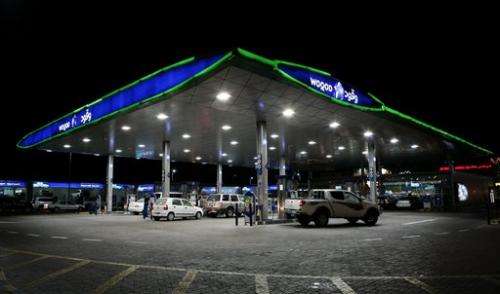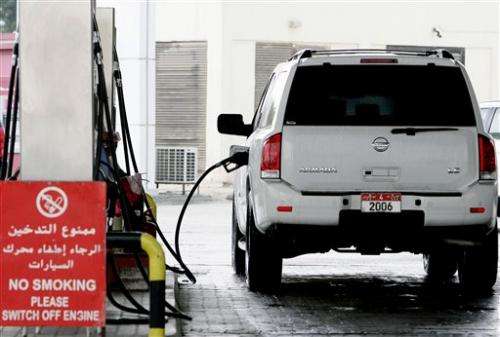This Saturday, Dec. 1, 2012 photo, shows the general view of a gas station in Doha, Qatar. The host of the current U.N. climate talks, Qatar, is among dozens of nations that keep gas prices low through subsidies that exceeded $500 billion globally last year. (AP Photo/Osama Faisal)
(AP)—The Middle East and North Africa will be especially hard hit by climate change in the coming decades, the World Bank said in a report Wednesday, saying the region will see less rainfall, more recording-breaking temperatures and rising sea levels.
Should temperatures rise as expected, the hotter conditions are likely to hit the region's $50 billion (€38.2 billion) tourism industry and further worsen its food security since many countries in the region—especially Gulf states—depend heavily on imports to feed their populations. Crop failures will also increase while yields will decrease and household incomes will fall, the report said.
The report was presented at the United Nations climate negotiations in Doha, Qatar, where nearly 200 delegates for the first time are in the Middle East to discuss cutting emissions in an attempt to ensure that global temperatures don't rise more than 2 degrees C (3.6 degrees F) over what they were in preindustrial times.
Temperatures have already risen about 0.8 degrees C (1.4 degrees F), according to the latest report by the IPCC.
"Climate change is a reality for people in Arab countries," Inger Andersen, World Bank Vice President for the Middle East and North Africa region, said in a statement.
"It affects everyone—especially the poor who are least able to adapt—and as the climate becomes ever more extreme, so will its impacts on people's livelihoods and wellbeing. The time to take actions at both the national and regional level in order to increase climate resilience is now," Andersen said.
In this Saturday, Dec. 1, 2012 photo, a man, unseen, fills his car with gasoline at a gas station in Doha, Qatar. The host of the current U.N. climate talks, Qatar, is among dozens of nations that keep gas prices low through subsidies that exceeded $500 billion globally last year. (AP Photo/Osama Faisal)
Among the most critical problems in the Middle East and North Africa will be worsening water shortages, the World Bank said. The region already has the lowest amount of freshwater in the world. With climate change, droughts in the region are expected to turn more extreme, water runoff is expected to decline 10 percent by 2050 while demand for water is expected to increase 60 percent by 2045.
The World Bank said the region—already suffering from searing summertime temperatures that can reach as high as 50 degrees Celsius (122 degrees Fahrenheit)—needs to start preparing for an even warmer world.
The report urged countries to ensure their national policies were "climate resilient," starting with "collecting climate data to strengthening basic services." It also called for improved access to services such as education, health and sanitation, along with strengthening of social safety nets to compensate for sudden loss of livelihood and training schemes to "give citizens the skills and resources to navigate climate challenges."
Countries need to improve their infrastructure with an eye on climate change, including improved drainage systems to address worsening floods and measures such as sea walls to address rising sea levels.
"Reducing vulnerability to climate change will require concerted action on multiple levels," said Rachel Kyte, World Bank Vice President for Sustainable Development. "Political leadership now will be critical in establishing climate change as a national and regional priority."
The report concluded that climate change is already happening in many parts of the Middle East and North Africa.
Over the past 30 years, climate disasters have affected 50 million people in the Arab world, costing about $12 billion (€ 9.2 billion) directly.
The report cited the 2006 flooding of the Nile River Basin, which caused 600 deaths, as well as the record five-year drought in the Jordan River Basin that ended in 2008. Of the 19 record temperatures in 2010, almost a quarter were from the Arab world, including Kuwait where temperatures reached 52.6 C (126.7 F) in 2010 and 53.5 C (128.3 F) in 2011.
In 2010, the Arabian Sea experienced its second-strongest cyclone on record, with winds as strong as 230 kilometers per hour (145 miles per hour) that killed 44 people and caused $700 million (€534.6 million) in damages in Oman.
Copyright 2012 The Associated Press. All rights reserved. This material may not be published, broadcast, rewritten or redistributed.

























